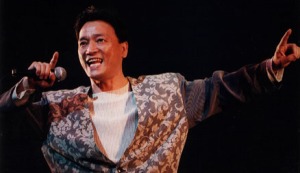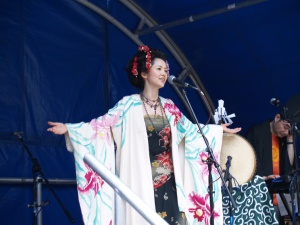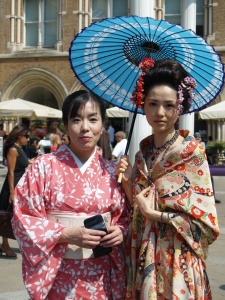One of the things Japanese music is known for is mixtures. Crazy mixtures. Emiko & KiriSute Gomen are the latest to contribute to a pantheon of extraordinary concoctions. Into the E&KSG music blender are added, in roughly equal quantities, minyo (Japanese folk), 60s psychedelic and surf. Stir in a dash each of jazz and swing, and a pinch of j-pop and punk. Now, blend on full power, and out comes something, quite unlike anything you’ve heard before. Or will in the future. Yet somehow manages to sound as if these diverse musical ingredients were made for each other. No mean feat.
Emiko & KiriSute Gomen are based in France, long a melting pot for creative musicians from the African diaspora, even from Vietnam, but never before from Japan.
Leader of the band, singer, taiko drummer and percussionist is Emiko Ota, who has been living in France for 10 years, initially to join a class in classical percussion. She soon morphed into a creative, multifaceted tour-de-force in the Parisian underground scene, playing with bands such as Fantazio, Les Elles, Urban Sax, Rihanna and Brain Damage, traditional group Ensemble Sakura and visiting Japanese musicians such as Otomo Yoshihide.
Electronic, classical, blues, dub, experimental, and Japanese minyo all came under her radar, as she performed in France and around the world in various guises at venues and festivals including Théâtre d’Arras, Musée National des Arts Asiatiques (Musée Guimet), Musée Jacques Chirac, La Cigale (Paris), French Embassies in Rome, Luxembourg and Paris for the ambassadors of Japan, at the Institut Franco-Japonais in Tokyo, Celtic Festival in Chicago (US), Festival de Gand (Belgium), Festival de Bourges (France), Festival International de Musique Sacrée in Sylvanes, Festival de Musique Classique in Saint- Jacques-de-Compostelle (Spain), Festival International des Emirats Arabes Unis, Festival International de Théâtre in Moscow, Pori Jazz Festival (Finland), and Glastonbury Festival (UK).
In 2011 she formed Emiko & KiriSute Gomen, focusing herself mainly on vocals to create music primarily based around minyo and other Japanese popular songs, but with extraneous influences she had encountered in France. Joining her are French musicians playing guitar, bass, shamisen (Japanese three stringed lute) and drums.
The backing band provides Emiko with the vehicle to express her chameleon musical abilities. Each song, traditional or contemporary is arranged by the band in a unique way, yet still pays respect to the original.
Folk music in Japan has always been in a process of constant evolution. Fittingly, in France, in the hands of the Emiko & KiriSute Gomen, minyo is undergoing more of a revolution.
Emiko & KiriSute Gomen’s first album Shyohatto was released in 2013.
Emiko Ota : lead vocals, taiko (Japanese percussion), drums
Julien Omeyer : guitar, bass, backing vocals
Sylvain Diony : shamisen (Japanese banjo), backing vocals
Simon Poncet: drums, backing vocals
Emiko & KuriSute Gomen are based in France and are available for shows and festivals worldwide in 2015. For more information or to book the group get in touch with us via the Far Side web site





